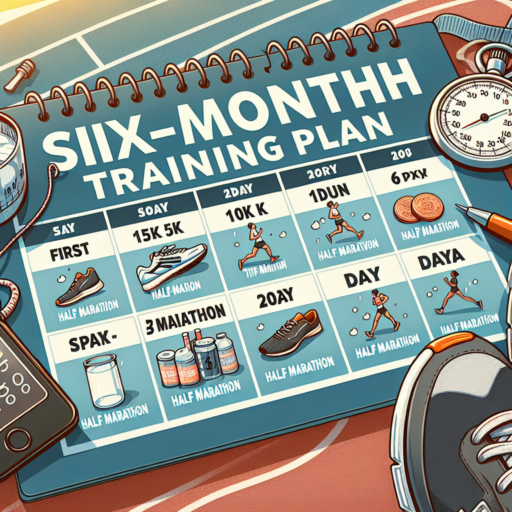Can I be ready for a half marathon in 6 months?
Preparing for a half marathon in 6 months is not only possible but can also be an enjoyable experience with proper planning and dedicated training. As a beginner, your primary focus should be on building stamina and endurance, gradually increasing the distance you cover. The key is starting slow and increasing your mileage each week by 10% to avoid injuries.
Importance of a Reliable Sports Watch
Now, this is where a reliable sports watch comes handy. For efficient training, tracking your progress is essential. Modern sports watches come with advanced features that monitor your heart rate, count your steps, and even track your route among many other functionalities. Book-marking your start and end times using a trustworthy sports watch can vastly improve your training quality
Aligning Your Training Regimen
Dividing your workout regimen into multiple stages can be extremely beneficial in being prepared for the marathon day. Begin your training with shorter runs to build a base then start integrating longer runs into your schedule. Focusing on speed drills, high endurance workouts, and regular rest days can vastly improve your performance. Weekly long runs are crucial in increasing your endurance level and should therefore be a crucial element of your training plan.
Incorporating Cross-training
In addition to running, your training regimen should incorporate cross-training activities like cycling or swimming. These activities offer great cardiovascular benefits without over-stressing your joints. Empower your training days with intensity and your resting days with active recovery, being sure to track your performance and recovery rates with your sports watch for optimal results.
Can you go from 0 to marathon in 6 months?
Facing the challenge of running a marathon can seem daunting, especially for beginners. However, when equipped with the right kind of training and determination, it is possible to go from 0 to marathon in just 6 months.
Setting Realistic Goals
Firstly, it is beneficial to understand that not everyone’s starting point is the same. Your initial pace, endurance level, and overall health will determine your training plan. In the context of a marathon, running 26.2 miles non-stop isn’t a goal that’s easy to achieve, it’s challenging. So, it’s crucial to set realistic goals and gradually increase your distance mile by mile.
Training and Preparation
Achieving marathon readiness in six months requires structured training and preparation. The key is to gradually increase the running distance and speed without causing injury or burn-out. A good way to measure progress is through a sports watch that tracks your speed, distance and heart rate. These data points can be beneficial for keeping your training on track and checking your overall fitness level.
Nourishment and Rest
Fueling your body with the proper nourishment is equally important as training. Eating a balanced diet focused on protein and carbohydrates ensure that you have the energy to sustain long-distance running. Additionally, getting enough rest and recovery time also plays a crucial role in preparing for a marathon. Hence, while aiming to go from 0 to marathon in six months, it’s important to pay attention to diet and rest along with your rigorous training sessions.
No se han encontrado productos.
How many months does it take to run a half marathon?
Running a half marathon is a significant fitness milestone that requires dedicated and structured training. The preparation period usually ranges from two to four months, considering that a beginner is in good health and maintains a decent basic fitness level. It’s vital to comprehend that these figures are mere estimates and can vary from person to person, depending on their individual fitness levels and goals.
The Importance of a Structured Training Program
The adoption of a structured half-marathon training plan is integral to efficiently utilising the time leading up to the event. This allows runners to gradually increase their endurance and strength, avoiding unprepared strain on the body. Depending on the plan, you can expect to start running distances of 3-5 miles, gradually working your way up to 13.1 miles over two to four months. A well-structured plan reduces the risk of injuries and ensures you are physically prepared to go the distance on race day.
Role of Personal Fitness Levels
Remember, your starting point plays a significant role; for someone with a regular running routine in place will require less time as compared to someone starting from scratch. Generally, experienced runners can prepare for a half marathon in two months, while beginners might need up to four months. It’s important to listen to your body and adjust your training schedule based on personal comfort and progress.
Adjusting for Your Personal Goals
How quick you can prepare for a half marathon also depends on your personal goals. If your target is just to finish, you might reach the required fitness level faster than someone aiming for a specific time. Pushing for speed requires more intensive training and hence, may require a longer training period.
How long do you need to go from couch to half marathon?
Transitioning from a sedentary lifestyle to running a half marathon is an impressive feat that requires time, patience, and determination. While the required duration varies from person to person, the typical timeframe ranges from 12 to 20 weeks. This allows your body to adapt gradually, minimizing the risk of injuries in the process.
Stages of Progression
Initially, the focus is on building endurance rather than speed. The first few weeks should be spent increasing your ability to run non-stop, starting from 20 minutes and gradually increasing the duration of time. At this juncture, do not be discouraged if you need to blend walking and running. In fact, this combination has been shown to be an effective way to increase overall running time. Once you are comfortable running for 30 to 60 minutes non-stop, you can start working on your speed and distance.
Weekly Mileage and Speed
Weekly mileage is another key factor in preparing for a half marathon. After building basic endurance, you should gradually increase your weekly running distance. This should be done at a comfortable pace without straining or pushing yourself too much. It takes time for your body to adjust to the increased mileage, so patience is essential here. Start with an increase of roughly 10% per week, and remember that rest days are just as crucial as training days in a running schedule.




